Trial of Susan B. Anthony for the crime of voting, June 17-18, 1873
Introduction
Author-Uploaded Audio
Listen to the opening section of the trial transcript of United States v Susan B. Anthony (narrated by Maria Kasper; LibriVox recording)
Text-to-speech Audio
Suffragist Susan B. Anthony was tried in June 1873 and convicted of the crime of illegally voting at the Ontario County Courthouse. Anthony had registered to vote and then voted in Rochester, NY during the 1872 presidential election. She had intended to attempt to register and when turned away, sue the register to push a legal case. However, she managed to actually vote and was then prosecuted for violating the Enforcement Act of 1870.
Images
Susan B. Anthony in 1870 (Nebraska State Historical Society)
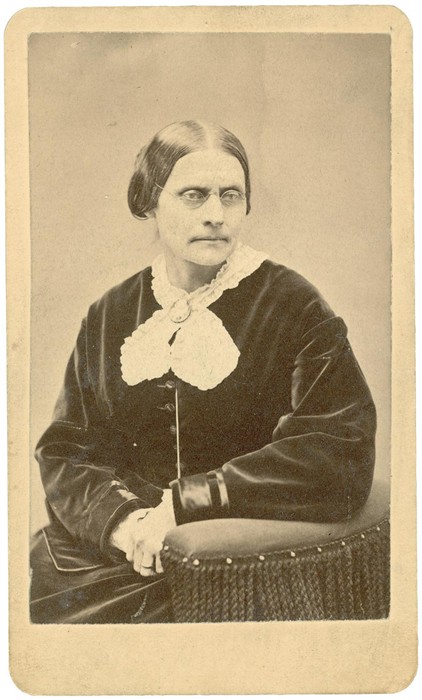
Ontario County Courthouse prior to the 1908 expansions
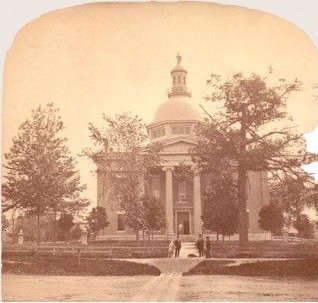
Henry R. Selden, attorney for Susan B. Anthony in the 1873 trial
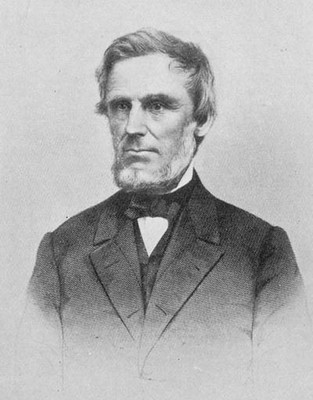
John Van Voorhis supported women's rights and advised Anthony and the other arrested women in their cases
_from_Monroe_County_Library.jpg)
Justice Ward Hunt presided of the Susan B. Anthony trial
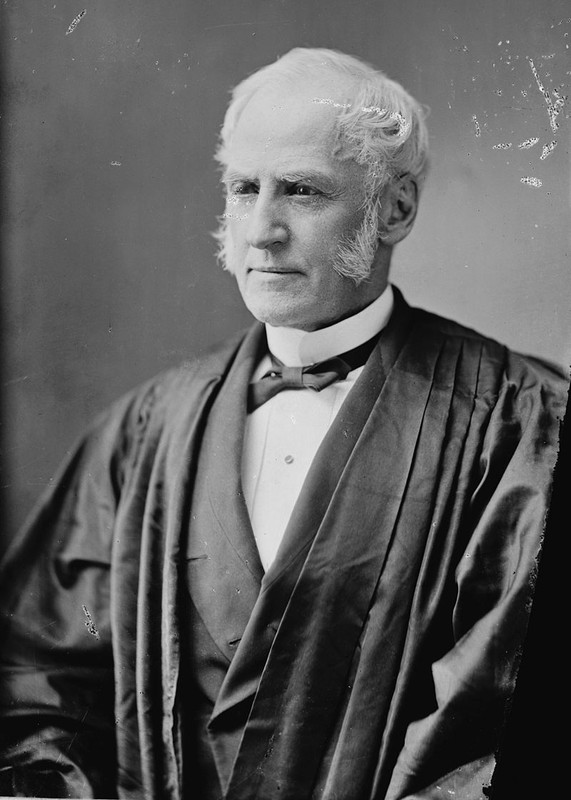
The New York Daily Graphic ran a story before Anthony's trial with this caricature on the front page
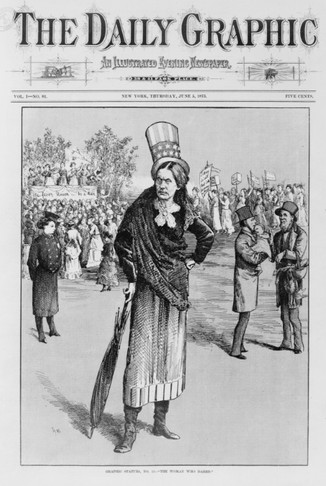
Courtroom in the Ontario County Courthouse in which Susan B. Anthony stood trial
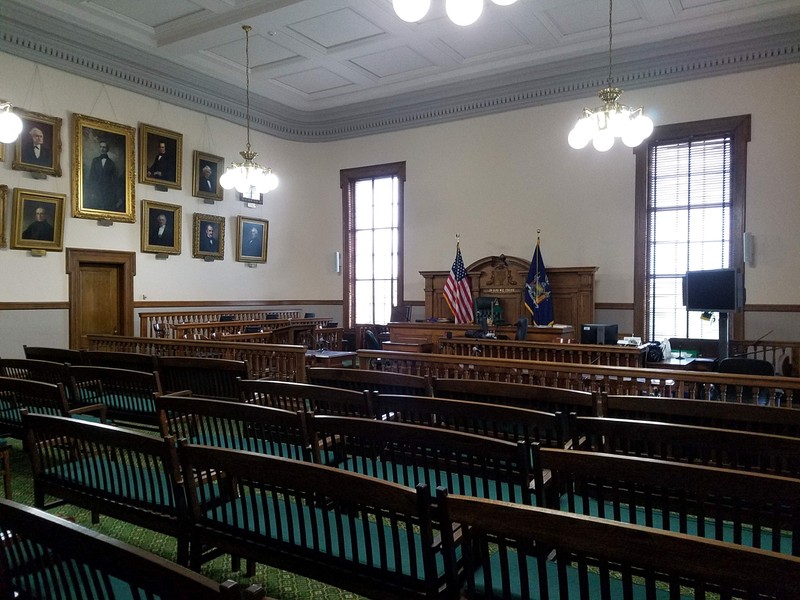
Portrait of Susan B. Anthony that hangs in the Ontario County Courthouse courtroom
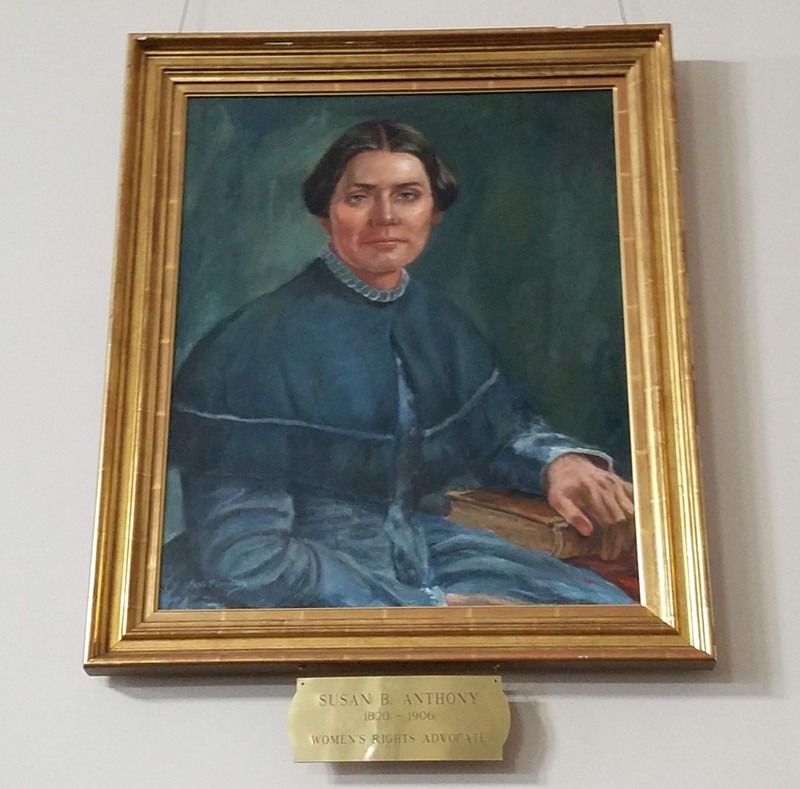
Bust of Susan B. Anthony outside the courtroom. The inscription reads "Susan B. Anthony, 1820-1906/Justice Denied Here, June 1873/Gift of Canandaigua B.P.W. & Friends"
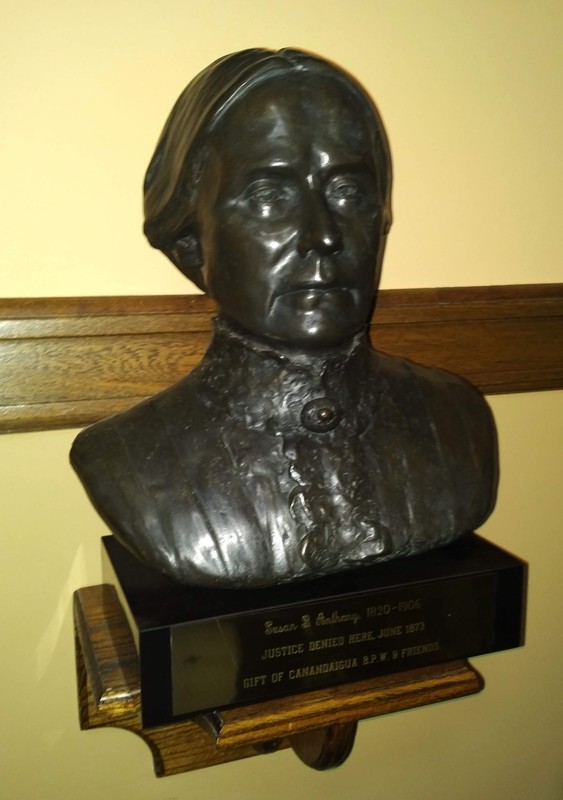
Letter from Susan B. Anthony to Elizabeth Cady Stanton about casting her vote, November 5, 1872
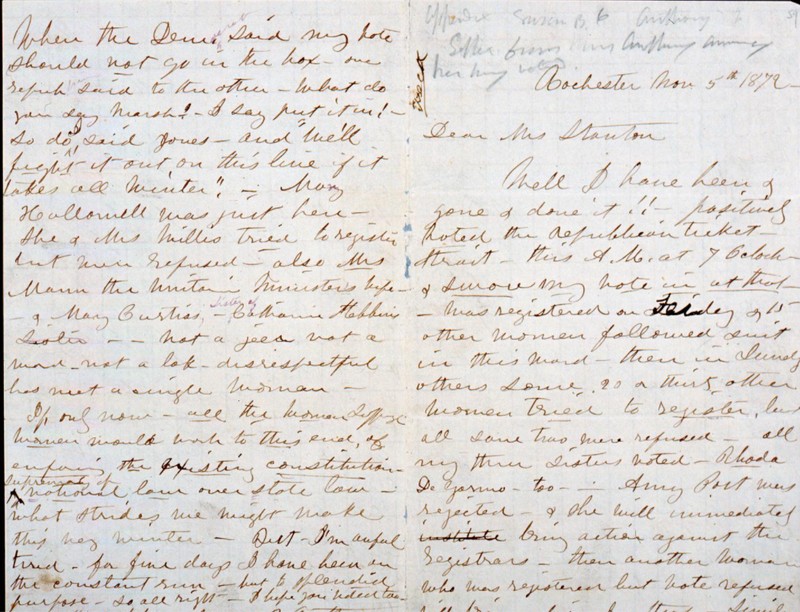
"Testimony of Mr. Beverly W. Jones, an election official in Rochester, New York, who was confronted by Susan B. Anthony on November 1, 1872, selected page"
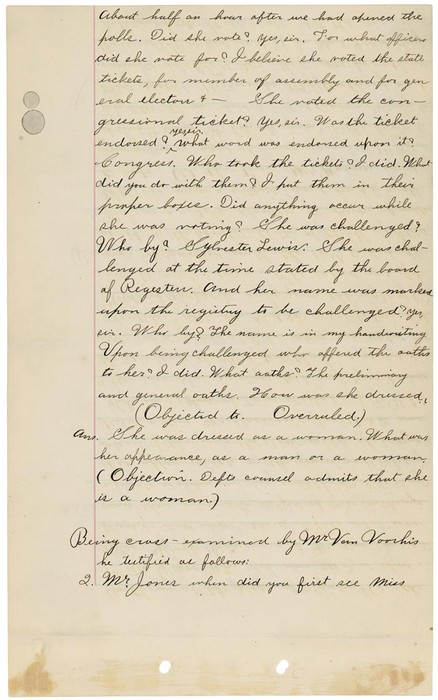
"Testimony of Mr. Beverly W. Jones, an election official in Rochester, New York, who was confronted by Susan B. Anthony on November 1, 1872, selected page"

Backstory and Context
Author-Uploaded Audio
Listen to the opening section of Susan B. Anthony's "Is It a Crime to Vote?" speech (narrated by Maria Kasper; LibriVox recording)
Text-to-speech Audio
Susan B. Anthony had been planning the strategy of attempting to vote and then pursuing legal action after she was refused some time before 1872. Anthony argued that the Fourteenth Amendment, ratified in 1868, allowed her to vote. The first section of the amendment reads:
“All persons born or naturalized in the United States, and subject to the jurisdiction thereof, are citizens of the United States and of the state wherein they reside. No state shall make or enforce any law which shall abridge the privileges or immunities of citizens of the United States; nor shall any state deprive any person of life, liberty, or property, without due process of law; nor deny to any person within its jurisdiction the equal protection of the laws.”
While the Fourteenth Amendment was added to the Constitution to address the situation of freed slaves in the aftermath of the Civil War, Anthony argued that since women were citizens, they should have the protected privilege of voting.
Anthony took her opportunity with the presidential election of 1872. On November 1, 1872 Anthony and 2-3 other women attempted to register as voters. Initially the registers did not want to let them, which is what the women expected, but when Anthony presented her arguments about her legal right to vote the registers allowed the women to register. In total, 14 women in Rochester, NY registered to vote on November 1.
On Election Day, November 5, 1872, Susan B. Anthony cast her ballot in Rochester, NY’s Eighth Ward, at the West End News Depot. Anthony voted for a Republican ticket, casting her ballot in support of Ulysses S. Grant for president. Immediately after Anthony and the other women registered, and again after they voted, the local press covered the story and the debates over the legality of their actions.
After casting her vote, Anthony wrote to her friend Elizabeth Cady Stanton:
Rochester Nov 5th 1872
Dear Mrs Stanton
Well I have been & gone & done it!!--positively voted the Republican ticket--strait this a.m. at 7 Oclock--& swore my vote in at that--was registered on Friday & 15 other women followed suit in this ward--then on Sunday others some 20 or thirty other women tried to register, but all save two were refused--all my three sisters voted--Roda De Garmo too--Amy Post was rejected & she will immediately bring action for that--similar to the Washington action--& Hon Henry R. Selden will be our Counsel--he has read up the law & all of our arguments & is satisfied that we our right & ditto the Old Judge Selden--his elder brother. so we are in for a fine agitation in Rochester on the question--I hope the morning's telegrams will tell of many women all over the country trying to vote--It is splendid that without any concert of action so many should have moved here so impromptu-- ....Haven't we wedged ourselves into the work pretty fairly & fully--& now that the Repubs have taken our votes--for it is the Republican members of the Board--The Democratic paper is out against us strong & that scared the Dem's on the registry board--How I wish you were here to write up the funny things said & done--Rhoda De Garmo told them that she wouldn't swear of affirm--"but would tell the truth"--& they accepted that When the Democrat said my vote should not go in the box--one Republican said to the other--What do you say Marsh!--I say put it in!--So do I said Jones--and "we'll fight it out on this line if it takes all winter"....If only now--all the women suffrage women would work to this end of enforcing the existing constitution--supremacy of national law over state law--what strides we might make this winter--But I'm awful tired--for five days I have been on the constant run--but to splendid purpose--So all right--I hope you voted too.
Affectionately,
Susan B. Anthony
Democratic poll watcher, Sylvester Lewis, filed a complaint after the election challenging both Anthony’s vote and her voter registration. As a result, United States Commissioner William C. Storrs issued a warrant for Anthony’s arrest on November 14. He did not immediately act on the warrant because he wanted to discuss the case with the U.S. Attorney for the Northern District of New York, but on November 18 a U.S. deputy marshal was sent to Anthony’s home. She was charged with voting in violation of the Enforcement Act of 1870. The marshal tried to be genteel about the arrest because Anthony was a woman, but Anthony demanded to be arrested in the same manner as a man. When Anthony was brought before Storrs after her arrest she found that the other 14 female voters and the ballot inspectors who had authorized the votes had also been arrested.
Susan B. Anthony was represented by Henry Selden and John Van Voorhis. Storrs held a preliminary examination on November 29, with a second examination on December 23, after which he determined that Anthony had likely broken the law. With a trial in the future, Susan B. Anthony undertook a speaking tour through Monroe County, presenting her speech “Is It a Crime for a U.S. Citizen to Vote?” at 29 locations in the county. She also dedicated time to sending out numerous letters to people to garner support for her case. Because of the publicity and Anthony’s efforts to gain support for her position, the U.S. Attorney Richard Crowley requested that the trial be moved to a new location for fear that they would not be able to get an impartial jury. Crowley requested that the trial be moved to the federal circuit court for the Northern New York District which would meet next in Canandaigua, Ontario County. In response Anthony continued her speaking tour in Ontario County leading up to the trial date.
Anthony’s trial was on June 17-18, 1873 with Justice Ward Hunt presiding. Hunt had recently been appointed to the U.S. Supreme Court and in both the trial and sentencing he did not allow Anthony to speak on her own behalf. Justice Hunt wrote his decision in the case prior to the trial and did not allow the jury to deliberate (this tactic was declared unconstitutional by the Supreme Court in 1895). Instead, Hunt ordered the jury to find Anthony guilty and fined her $100. He specifically did not put Anthony in jail because he wanted to avoid an appeal process.
Susan B. Anthony and her 14 fellow Rochester women were not the only ones who attempted to vote in the 1872 election. In total, about 150 women attempted to register or vote that year. Virginia Minor of St. Louis attempted to register as a voter and was turned away. Minor followed the tactic that Anthony had intended to use, after her registration was rejected Minor sued the register in a case that went all the way to the U.S. Supreme Court. In Minor v Happersett the Supreme Court ruled that citizenship means “membership in a nation and nothing more.” This decision refuted Anthony’s interpretation of the Fourteenth Amendment and remained in place until the ratification of the Nineteenth Amendment.
Susan B. Anthony never paid the $100 fine and she never sought a pardon for her conviction. She viewed the conviction as a matter of pride in the fight for women’s suffrage. However, President Donald J. Trump pardoned Anthony on August 18, 2020 as part of the centennial of women’s suffrage.
The original Ontario County Courthouse is now City Hall, across the street. The current courthouse was constructed in 1858 for about $57,000. The structure was enlarged in 1908 with the addition of a third floor and extensions to the north and south. The courthouse was preserved through extensive renovations in 1987-1988 and 2016. A bust of Susan B. Anthony is outside the courtroom entrance and a portrait of her hangs inside the courtroom.
Sources
“The Arrest of Susan B. Anthony.” Freethought Trail. Accessed November 1, 2021. https://freethought-trail.org/historical-events/event:susan-b-anthony-arrested-for-voting/.
“Freethought Trail Spotlights Susan B. Anthony’s Trial for Voting.” Freethought Trail. September 4, 2019. Accessed November 1, 2021. https://freethought-trail.org/latest-news/article:freethought-trail-spotlights-susan-b-anthonys-trial-for-voting/.
Linder, Douglas O. “Letters & Diary Entries of Susan B. Anthony Concerning Her Casting a Vote in the 1872 Federal Election.” Famous Trials. Accessed November 3, 2021. https://famous-trials.com/anthony/441-voteletters.
Linder, Douglas O. “The Trial of Susan B. Anthony: An Account.” Famous Trials. Accessed November 2, 2021. https://famous-trials.com/anthony/444-home.
“Ontario County Courthouse.” Accessed November 2, 2021. https://www.nycourts.gov/HISTORY/legal-history-new-york/images-courthouses/courthouses-seventh-ontario.html.
“Suffragist.” The National Susan B. Anthony Museum & House. Accessed November 1, 2021. https://susanb.org/suffragist/.
“Susan B. Anthony Trial Site.” Freethought Trail. Accessed November 1, 2021. https://freethought-trail.org/trail-map/location:trial-of-susan-b-anthony/.
"Confrontations for Justice: Mr. Beverly Jones--Susan B. Anthony at the Voting Polls, 1872." Eyewitness: American Originals from the National Archives. Accessed November 3, 2021. https://www.archives.gov/exhibits/eyewitness/html.php?section=3.
"Public Square." Ontario County, New York. Accessed November 3, 2021. https://www.ontariocountyny.gov/870/Public-Square.
"Trial of Susan B. Anthony." Wikipedia. Accessed November 3, 2021. https://en.wikipedia.org/wiki/Trial_of_Susan_B._Anthony.
"Trial of Susan B. Anthony." Wikipedia. Accessed November 3, 2021. https://en.wikipedia.org/wiki/Trial_of_Susan_B._Anthony.
"Trial of Susan B. Anthony." Wikipedia. Accessed November 3, 2021. https://en.wikipedia.org/wiki/Trial_of_Susan_B._Anthony.
"Trial of Susan B. Anthony." Wikipedia. Accessed November 3, 2021. https://en.wikipedia.org/wiki/Trial_of_Susan_B._Anthony.
“Susan B. Anthony Trial Site.” Freethought Trail. Accessed November 3, 2021. https://freethought-trail.org/trail-map/location:trial-of-susan-b-anthony/.
“Susan B. Anthony Trial Site.” Freethought Trail. Accessed November 3, 2021. https://freethought-trail.org/trail-map/location:trial-of-susan-b-anthony/.
“Susan B. Anthony Trial Site.” Freethought Trail. Accessed November 3, 2021. https://freethought-trail.org/trail-map/location:trial-of-susan-b-anthony/.
"Letters & Diary Entries of Susan B. Anthony Concerning Her Casting a Vote in the 1872 Federal Election." Famous Trials. Accessed November 3, 2021. https://famous-trials.com/anthony/441-voteletters.
"Confrontations for Justice: Mr. Beverly Jones--Susan B. Anthony at the Voting Polls, 1872." Eyewitness: American Originals from the National Archives. Accessed November 3, 2021. https://www.archives.gov/exhibits/eyewitness/html.php?section=3.
"Confrontations for Justice: Mr. Beverly Jones--Susan B. Anthony at the Voting Polls, 1872." Eyewitness: American Originals from the National Archives. Accessed November 3, 2021. https://www.archives.gov/exhibits/eyewitness/html.php?section=3.
